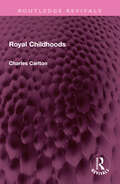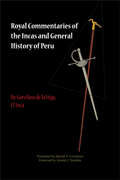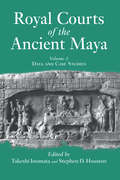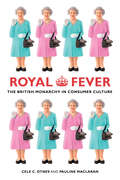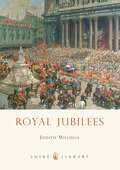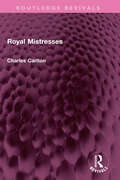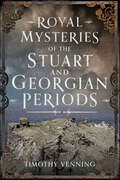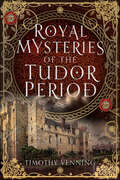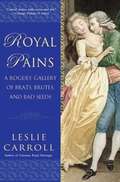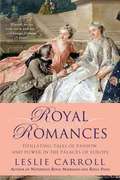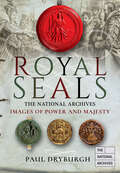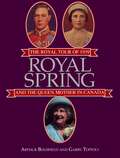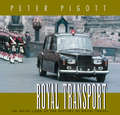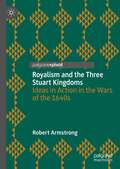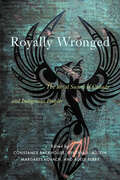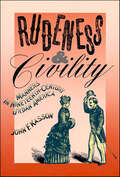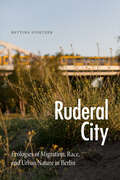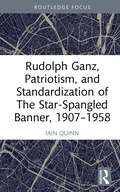- Table View
- List View
Royal Childhoods (Routledge Revivals)
by Charles CarltonFirst published in 1986, Royal Childhoods shows how the early years of Britain’s kings and queen have coloured their later lives. Combining skills of a professional historian with a knowledge of psychology, the author links the study of childhood to known pattern of events. His book makes the distant figures of royalty more comprehensible as individuals. With great insight into the influence of childhood experience, he covers the whole span of British monarchy from William the Conqueror to the Prince of Wales. This book will be of interest to students of history, literature and psychology.
Royal Commentaries of the Incas and General History of Peru, Parts One and Two
by Garcilaso de la VegaThe two-part classic history of the Incan empire&’s origin and growth, as well as their demise following the arrival of the Spaniards.Garcilaso de la Vega, the first native of the New World to attain importance as a writer in the Old, was born in Cuzco in 1539, the illegitimate son of a Spanish cavalier and an Inca princess. Although he was educated as a gentleman of Spain and won an important place in Spanish letters, Garcilaso was fiercely proud of his Indian ancestry and wrote under the name EI Inca.Royal Commentaries of the Incas is the account of the origin, growth, and destruction of the Inca empire, from its legendary birth until the death in 1572 of its last independent ruler. For the material in Part One of Royal Commentaries—the history of the Inca civilization prior to the arrival of the Spaniards—Garcilaso drew upon &“what I often heard as a child from the lips of my mother and her brothers and uncles and other elders . . . [of] the origin of the Inca kings, their greatness, the grandeur of their empire, their deeds and conquests, their government in peace and war, and the laws they ordained so greatly to the advantage of their vassals.&”The conventionalized and formal history of an oral tradition, Royal Commentaries describes the gradual imposition of order and civilization upon a primitive and barbaric world. To this Garcilaso adds facts about the geography and the flora and fauna of the land; the folk practices, religion, and superstitions; the agricultural and the architectural and engineering achievements of the people; and a variety of other information drawn from his rich store of traditional knowledge, personal observation, or speculative philosophy. Important though it is as history, Garcilaso&’s classic is much more: it is also a work of art. Its gracious and graceful style, skillfully translated by Harold V. Livermore, succeeds in bringing to life for the reader a genuine work of literature.
Royal Commentaries of the Incas and General History of Peru, Parts One and Two
by Garcilaso de la VegaThe two-part classic history of the Incan empire&’s origin and growth, as well as their demise following the arrival of the Spaniards.Garcilaso de la Vega, the first native of the New World to attain importance as a writer in the Old, was born in Cuzco in 1539, the illegitimate son of a Spanish cavalier and an Inca princess. Although he was educated as a gentleman of Spain and won an important place in Spanish letters, Garcilaso was fiercely proud of his Indian ancestry and wrote under the name EI Inca.Royal Commentaries of the Incas is the account of the origin, growth, and destruction of the Inca empire, from its legendary birth until the death in 1572 of its last independent ruler. For the material in Part One of Royal Commentaries—the history of the Inca civilization prior to the arrival of the Spaniards—Garcilaso drew upon &“what I often heard as a child from the lips of my mother and her brothers and uncles and other elders . . . [of] the origin of the Inca kings, their greatness, the grandeur of their empire, their deeds and conquests, their government in peace and war, and the laws they ordained so greatly to the advantage of their vassals.&”The conventionalized and formal history of an oral tradition, Royal Commentaries describes the gradual imposition of order and civilization upon a primitive and barbaric world. To this Garcilaso adds facts about the geography and the flora and fauna of the land; the folk practices, religion, and superstitions; the agricultural and the architectural and engineering achievements of the people; and a variety of other information drawn from his rich store of traditional knowledge, personal observation, or speculative philosophy. Important though it is as history, Garcilaso&’s classic is much more: it is also a work of art. Its gracious and graceful style, skillfully translated by Harold V. Livermore, succeeds in bringing to life for the reader a genuine work of literature.
Royal Courts Of The Ancient Maya: Volume 1: Theory, Comparison, And Synthesis
by Takeshi InomataThe two volumes of Royal Courts of the Ancient Maya provide current archaeological perspectives on Maya courts conceived as vital, functioning social groups composed of lords, courtiers, scribes, priests, and entertainers, among many others. In addition to archaeological data on the architecture and other spatial attributes of courts, the studies in the two volumes bring to bear on the topic the most recent evidence from inscriptions, vase paintings, murals and friezes, and ethnohistoric records in order to flesh out a portrait of the actors and roles that made up Maya courts through time and across space. The attributes of courts are explored in the Maya highlands and lowlands, from the origins of early kingship through the Classic period to the Postclassic and Terminal epochs. Pertinent comparisons are also drawn from the Aztecs and other ancient and contemporary societies. Volume 1: Theory, Comparison, and Synthesis establishes a carefully considered framework for approaching the study of courts and their functions throughout the world of the ancient Maya. Volume 2: Data and Case Studies provides authoritatively current data and insights from key Maya sites, including Cop? Tikal, Caracol, Bonampak, and Calakmul.
Royal Courts Of The Ancient Maya: Volume 2: Data And Case Studies
by Takeshi InomataThe two volumes of Royal Courts of the Ancient Maya provide current archaeological perspectives on Maya courts conceived as vital, functioning social groups composed of lords, courtiers, scribes, priests, and entertainers, among many others. In addition to archaeological data on the architecture and other spatial attributes of courts, the studies in the two volumes bring to bear on the topic the most recent evidence from inscriptions, vase paintings, murals and friezes, and ethnohistoric records in order to flesh out a portrait of the actors and roles that made up Maya courts through time and across space. The attributes of courts are explored in the Maya highlands and lowlands, from the origins of early kingship through the Classic period to the Postclassic and Terminal epochs. Pertinent comparisons are also drawn from the Aztecs and other ancient and contemporary societies. Volume 1: Theory, Comparison, and Synthesis establishes a carefully considered framework for approaching the study of courts and their functions throughout the world of the ancient Maya. Volume 2: Data and Case Studies provides authoritatively current data and insights from key Maya sites, including Cop? Tikal, Caracol, Bonampak, and Calakmul.
Royal Fever
by Cele C. Otnes Pauline MaclaranNo monarchy has proved more captivating than that of the British Royal Family. Across the globe, an estimated 2.4 billion people watched the wedding of Prince William and Catherine Middleton on television. In contemporary global consumer culture, why is the British monarchy still so compelling? Rooted in fieldwork conducted from 2005 to 2014, this book explores how and why consumers around the world leverage a wide range of products, services, and experiences to satisfy their fascination with the British Royal Family brand. It demonstrates the monarchy's power as a brand whose narrative has existed for more than a thousand years, one that shapes consumer behavior and that retains its economic and cultural significance in the twenty-first century. The authors explore the myriad ways consumer culture and the Royal Family intersect across collectors, commemorative objects, fashion, historic sites, media products, Royal brands, and tourist experiences.Taking a case study approach, the book examines both producer and consumer perspectives. Specific chapters illustrate how those responsible for orchestrating experiences related to the British monarchy engage the public by creating compelling consumer experiences. Others reveal how and why people devote their time, effort, and money to Royal consumption--from a woman who boasts a collection of over 10,000 pieces of British Royal Family trinkets to a retired American stockbroker who spends three months each year in England hunting for rare and expensive memorabilia. Royal Fever highlights the important role the Royal Family continues to play in many people's lives and its ongoing contribution as a pillar of iconic British culture.
Royal Jubilee
by Judith MillidgeIn 1809, thanksgiving ceremonies and feasts across Britain ushered George III into his fiftieth year as king. This was the first British celebration of a royal jubilee and set the tone for the five that have followed since: processions, fireworks, construction of monuments, the striking of special coins and medals, and, of course, the sale of commemorative mugs. Queen Victoria marked her golden and diamond jubilees in 1887 and 1897 amid throngs of patriotic subjects from all over the world, and celebrations were also held for George V's silver jubilee in 1935. Following the festivities in 1977 and 2002, Queen Elizabeth II is the first British monarch ever to celebrate her third jubilee, as she begins her seventh decade on the throne. Judith Millidge describes the handful of British royal jubilees across 200 years, examines how they have been commemorated, their similarities and differences, and the myriad souvenir products that have accompanied them.
Royal Mistresses (Routledge Revivals)
by Charles CarltonFirst published in 1990, Royal Mistresses provides an innovative way of looking at the development of British monarchy, and at the same time investigates the relationship between sex and power. Charles Carlton focuses not so much on the amorous activities of the mistresses of British monarchs as on their influences on those monarchs and on society at large. Ranging from the early medieval period to the late 1990s, he shows that a monarch’s illicit sexual life sheds light on his character and reign. It is no coincidence that Henry I, Charles II, and Edward VII, who were successful with their mistresses were also successful in their reigns, while the divorced John and the lovelorn Edward VIII failed Not surprisingly, the affairs of the sovereign’s heart have very often become the affairs of state. This book will be of interest to students of history and literature.
Royal Mysteries of the Stuart and Georgian Periods
by Timothy VenningBoth interesting and disturbing, learn all about the alleged attempt to murder James I and VI before the became King of England, the plots at court involving 'poisoned tarts', to the marriage court scandal of George III. 'There is nothing new under the sun', a phrase ascribed originally to King Solomon, applies to the present book, with echoes of 'modern' themes exposing royal scandal, sex, corruption, political absolutism - attempted - religious controversy, danger of mass-terrorism, murder and 'suspicious' deaths, 'fake news' and international threat from superpowers. And all focusing on inside stories which today would be 'investigative journalism' with huge popular media interest. This is history for both specialists and, especially, for general readers, given media interest, including TV and film coverage in 'exciting' popular history, as set out by the author. The earlier 'Royal Mysteries' in the series were full of tragedy, suffering, pathos, heroism and romance, but the present set are equally interesting and disturbing and revisionist. These include the alleged attempt to murder James I and VI before the became King of England; the scandal at court involving 'poisoned tarts', James' 'toy-boy', and a subsequent murder trial. And the following questions and mysteries: did Charles II really promise to convert to Catholicism to please Louis XIV; did Charles marry his mistress Lucy Walter, mother of rebel Duke of Monmouth; was James II and VII an enlightened religious reformer or trying to convert England to Catholicism - the religion of European superpowers; did George I 'disappear' (a 'hit' in modern terms) his divorced wife's lover before ascending the English throne; did the unpopular Duke of Cumberland murder his gay lover; did the hugely admired 'respectable' George III, devoted husband and father, marry a middle-class Quaker woman?
Royal Mysteries of the Tudor Period
by Timothy VenningUncover the secrets haunting the Medieval royal court in this page-turning delve into the Tudor's dark past. The Tudor period is familiar to British public in reading and viewing in books, TV series and film - the list is endless, from Shakespeare and Fletcher in the 1600s to Hilary Mantel et al, and involving internationally famous authors and actors. This is backdrop to the 'Royal Mysteries' which reflect aspects of enduring modern interest. These include royal family drama, sex, scandal, violence, tragedy, murder both judicial and from personal rivalry. The period is dominated and overshadowed by the gigantic and brutal figure of Henry VIII , the 'British Stalin', with his six wives with two got rid of by judicial murder. Royal Mysteries occur throughout the period. The battle of Bosworth Field in 1485 did not end the Wars of the Roses, Henry VII's claim was disputed by Pretenders, and following the unresolved disappearance of the 'Princes in the Tower', Lambert Simnel and Perkin Warbeck with considerable and allegedly Yorkist support. Then came Anne Boleyn, who to many, including modern writers and top historians, a religious reformer, idealist and gifted woman, ruthlessly put down and maligned and executed by the brutal Henry VIII and victim of manipulating figures like Cromwell in a royal court full of 'spin' and 'fake news'. And the stories Elizabeth I and Mary Queen of Scots are similarly packed with mystery and scandal. Elizabeth's possible suitor and potential husband was Robert Dudley and his ailing wife died in suspicious circumstances. And the long saga of Elizabeth and Mary involved Mary's tangled affairs involving murder and conspiracy to replace Elizabeth on the English throne.
Royal Pains
by Leslie CarrollThe author of Notorious Royal Marriages presents some of history's boldest, baddest, and bawdiest royals. The bad seeds on the family trees of the most powerful royal houses of Europe often became the most rotten of apples: über-violent autocrats Vlad the Impaler and Ivan the Terrible literally reigned in blood. Lettice Knollys strove to mimic the appearance of her cousin Elizabeth I and even stole her man. And Pauline Bonaparte scandalized her brother Napoleon by having a golden goblet fashioned in the shape of her breast. Chock-full of shocking scenes, titillating tales, and wildly wicked nobles, Royal Pains is a rollicking compendium of the most infamous, capricious, and insatiable bluebloods of Europe. .
Royal Pains
by Leslie CarrollThe author of Notorious Royal Marriages presents some of history's boldest, baddest, and bawdiest royals. The bad seeds on the family trees of the most powerful royal houses of Europe often became the most rotten of apples: über-violent autocrats Vlad the Impaler and Ivan the Terrible literally reigned in blood. Lettice Knollys strove to mimic the appearance of her cousin Elizabeth I and even stole her man. And Pauline Bonaparte scandalized her brother Napoleon by having a golden goblet fashioned in the shape of her breast. Chock-full of shocking scenes, titillating tales, and wildly wicked nobles, Royal Pains is a rollicking compendium of the most infamous, capricious, and insatiable bluebloods of Europe.
Royal Pains
by Leslie CarrollThe author of Notorious Royal Marriages presents some of history's boldest, baddest, and bawdiest royals. The bad seeds on the family trees of the most powerful royal houses of Europe often became the most rotten of apples: über-violent autocrats Vlad the Impaler and Ivan the Terrible literally reigned in blood. Lettice Knollys strove to mimic the appearance of her cousin Elizabeth I and even stole her man. And Pauline Bonaparte scandalized her brother Napoleon by having a golden goblet fashioned in the shape of her breast. Chock-full of shocking scenes, titillating tales, and wildly wicked nobles, Royal Pains is a rollicking compendium of the most infamous, capricious, and insatiable bluebloods of Europe.
Royal Romances: Titillating Tales of Passion and Power in the Palaces of Europe
by Leslie CarrollMore breathtaking than any fairy tale, here are seven scandalous, seductive centuries of all-for-love royal desire . . . Elegant palaces, dazzling power plays, shimmering jewels, and the grandest of all-or-nothing gambles—nothing can top real-life love among the royalty. Louis XIV defied God and law, permitting his married mistress Madame de Montespan to usurp the role of Queen of France, then secretly wed her successor, Madame de Maintenon. Grigory Potemkin was a worthy equal in Catherine the Great’s bed as well as in Russia’s political arena. Dashing Count Axel von Fersen risked everything to save Marie Antoinette’s life more than once—and may have returned her passion. The unshakable devotion of the beloved late “Queen Mum” helped King George VI triumph over his, and England’s, darkest hours. And the unpretentious, timelessly glamorous—even relatable—union of Prince William and the former Kate Middleton continues to enthrall the world. Full of marvelous tales, unforgettable scandals, and bedazzled nobles who refused to rule their hearts, this delightfully insightful book is what the sweetest royal dreams are made of. . . .
Royal Seals: Images of Power and Majesty (Images Of The The National Archives Ser.)
by Paul Dryburgh“An intriguing look into the past through The National Archives . . . It offers a glimpse into the different seals of the monarchs, nobility, and clergy.” —Tudor BloggerRoyal Seals is an introduction to the seals of the kings and queens of England, Scotland and latterly the United Kingdom, as well as the Church and nobility.Ranging from Medieval times to modern day, it uses images of impressive wax seals held at The National Archives to show the historical importance of these beautiful works of art.Included are features on the great seals of famous monarchs like Richard III, Henry VIII, Elizabeth I and twentieth-century monarchs, as well as insights on the role of seals in treaties and foreign policy.With ecclesiastical seals and those of the nobility and lower orders included, this is a comprehensive and lavishly illustrated guide.“It is actually very fascinating as the book looks at the different types of seal used by various monarchs and why the seal came into being. We read about some of the most notable monarchs such as Charles II, George IV, James I, Henry VIII and more. But what has to be the best part of this book produced in conjunction with The National Archives, is the high quality of the pictures, certainly fantastic and really do show off the book at its best.” —UK Historian“The book should interest readers of Medieval Archaeology, providing a good introduction to the subject through what is undoubtedly an amazing national collection.” —Medieval Archaeology
Royal Spring: The Royal Tour of 1939 and the Queen Mother in Canada
by Arthur Bousfield Garry ToffoliA beautiful and nostalgic look at the royal tour that captured a generation — the first visit of a reigning monarch to Canada. This six week visit from the Atlantic to the Pacific and back again (with a short excursion to the United States) enthralled a young nation. Fifty years ago, King George VI and Queen Elizabeth arrived at Quebec City to tour "the senior daughter of the dominions". This is a fond recollection of those few magic weeks and the outpouring of affection for the new king and his beautiful wife. Filled with contemporary pictures and anecdotes, this book captures the feeling of the times with a look at the way Canadians reacted to seeing their sovereign: the formal and informal photographs, the speeches and tributes, the advertising art, the menus for formal dinners, the music and poetry composed for the event. The second section of the book chronicles the King and Queen’s other visits to Canada before and after that epochal visit. The King was here as a young man. The Queen Mother has been to Canada many times since 1939, and in a moving speech at Queen’s Park in Toronto in 1979 reflecting on the tour she said "I lost my heart to Canada and Canadians…." Royal Spring includes an 8-page section on the most recent and golden anniversary visit — July 1989.
Royal Transport: An Inside Look at The History of British Royal Travel
by Peter PigottThe conveyance of royalty, whether to Balmoral or Buffalo, by Rolls Royce or Canadian Pacific train, has its own mysterious traditions and protocols. With dry humour and a keen sense of history, Peter Pigott describes how the British royal family has adapted to technological innovations. Organized thematically, the book is packed with well-researched details. We know all about the royal family’s lives, especially their romances and scandals, but do we know who was the first monarch to drive a motorcar? The first to fly in an aircraft? Which king so loved his yacht that he ordered it scuttled on his death?Royal Transport is a fascinating look at how British royalty has travelled since the invention of steam. This richly illustrated book covers all modes of royal transport in Britain and the Commonwealth - some of the most famous and yet unknown transport in the world.
Royalism and the Three Stuart Kingdoms: Ideas in Action in the Wars of the 1640s
by Robert ArmstrongThis book addresses a conundrum. Alone of the major competing political interests during the civil wars of the 1640s, royalism needed to transcend attachment to one nation or one religious tradition and recruit a support base in each of England, Ireland and Scotland. This book aims to provide a concise interpretation and reassessment of royalism during these crucial years and focuses on this dilemma, and on the resources, intellectual and practical, deployed to address it, with mixed success. It focuses on the key ideas and values which made royalism a formidable political alternative, rather than on the more usual factional, military or literary perspectives. It argues that a ‘three-kingdom’ perspective not only gives a broader view but also clarifies the distinctive characteristics of English royalism, more robust than its counterparts in the other nations.
Royally Wronged: The Royal Society of Canada and Indigenous Peoples
by Constance Backhouse, Cynthia E. Milton, Margaret Kovach, and Adele PerryThe Royal Society of Canada’s mandate is to elect to its membership leading scholars in the arts, humanities, social sciences, and sciences, lending its seal of excellence to those who advance artistic and intellectual knowledge in Canada. Duncan Campbell Scott, one of the architects of the Indian residential school system in Canada, served as the society’s president and dominated its activities; many other members – historically overwhelmingly white men – helped shape knowledge systems rooted in colonialism that have proven catastrophic for Indigenous communities.Written primarily by current Royal Society of Canada members, these essays explore the historical contribution of the RSC and of Canadian scholars to the production of ideas and policies that shored up white settler privilege, underpinning the disastrous interaction between Indigenous peoples and white settlers. Historical essays focus on the period from the RSC’s founding in 1882 to the mid-twentieth century; later chapters bring the discussion to the present, documenting the first steps taken to change damaging patterns and challenging the society and Canadian scholars to make substantial strides toward a better future.The highly educated in Canadian society were not just bystanders: they deployed their knowledge and skills to abet colonialism. This volume dives deep into the RSC’s history to learn why academia has more often been an aid to colonialism than a force against it. Royally Wronged poses difficult questions about what is required – for individual academics, fields of study, and the RSC – to move meaningfully toward reconciliation.
Rubber Boots Methods for the Anthropocene: Doing Fieldwork in Multispecies Worlds
by Nils Bubandt Astrid Oberborbeck Andersen Rachel CypherA methodological follow-up to Arts of Living on a Damaged Planet The environmental and climatic crises of our time are fundamentally multispecies crises. And the Anthropocene, a time of &“human-made&” disruptions on a planetary scale, is a disruption of the fabric of life as a whole. The contributors to Rubber Boots Methods for the Anthropocene argue that understanding the multispecies nature of these disruptions requires multispecies methods.Answering methodological challenges posed by the Anthropocene, Rubber Boots Methods for the Anthropocene retools the empirical study of the socioecological chaos of the contemporary moment across the arts, human science, and natural science. Based on critical landscape history, multispecies curiosity, and collaboration across disciplines and knowledge systems, the volume presents thirteen transdisciplinary accounts of practical methodological experimentation, highlighting diverse settings ranging from the High Arctic to the deserts of southern Africa and from the pampas of Argentina to the coral reefs of the Western Pacific, always insisting on the importance of firsthand, &“rubber boots&” immersion in the field.The methodological companion to Arts of Living on a Damaged Planet: Ghosts and Monsters of the Anthropocene (Minnesota, 2017), this collection puts forth empirical studies of the multispecies messiness of contemporary life that investigate some of the critical questions of our time.Contributors: Filippo Bertoni, Museum für Naturkunde, Berlin; Harshavardhan Bhat, U of Westminster; Nathalia Brichet, U of Copenhagen; Janne Flora, Aarhus U, Denmark; Natalie Forssman, U of British Columbia; Peter Funch, Aarhus U; Kirsten Hastrup, U of Copenhagen; Colin Hoag, Smith College; Joseph Klein, U of California, Santa Cruz; Andrew S. Mathews, U of California, Santa Cruz; Daniel Münster, U of Oslo; Ursula Münster, U of Oslo; Jon Rasmus Nyquist, U of Oslo; Katy Overstreet, U of Copenhagen; Pierre du Plessis, U of Oslo; Meredith Root-Bernstein; Heather Anne Swanson, Aarhus U; Anna Lowenhaupt Tsing, U of California,Santa Cruz; Stine Vestbo.
Rubble: The Afterlife of Destruction
by Gastón R. GordilloAt the foot of the Argentine Andes, bulldozers are destroying forests and homes to create soy fields in an area already strewn with rubble from previous waves of destruction and violence. Based on ethnographic research in this region where the mountains give way to the Gran Chaco lowlands, Gastón R. Gordillo shows how geographic space is inseparable from the material, historical, and affective ruptures embodied in debris. His exploration of the significance of rubble encompasses lost cities, derelict train stations, overgrown Jesuit missions and Spanish forts, stranded steamships, mass graves, and razed forests. Examining the effects of these and other forms of debris on the people living on nearby ranches and farms, and in towns, Gordillo emphasizes that for the rural poor, the rubble left in the wake of capitalist and imperialist endeavors is not romanticized ruin but the material manifestation of the violence and dislocation that created it.
Rudeness & Civility: Manners in Nineteenth-Century Urban America
by John F. KassonWith keen insight and subtle humor, John F. Kasson explores the history and politics of etiquette from America's colonial times through the nineteenth century. He describes the transformation of our notion of "gentility," once considered a birthright to some, and the development of etiquette as a middle-class response to the new urban and industrial economy and to the excesses of democratic society.
Ruderal City: Ecologies of Migration, Race, and Urban Nature in Berlin (Experimental Futures)
by Bettina StoetzerIn Ruderal City Bettina Stoetzer traces relationships among people, plants, and animals in contemporary Berlin as they make their lives in the ruins of European nationalism and capitalism. She develops the notion of the ruderal—originally an ecological designation for the unruly life that inhabits inhospitable environments such as rubble, roadsides, train tracks, and sidewalk cracks—to theorize Berlin as a “ruderal city.” Stoetzer explores sites in and around Berlin that have figured in German national imaginaries—gardens, forests, parks, and rubble fields—to show how racial, class, and gender inequalities shape contestations over today’s uses and knowledges of urban nature. Drawing on fieldwork with gardeners, botanists, migrant workers, refugees, public officials, and nature enthusiasts while charting human and more-than-human worlds, Stoetzer offers a wide-ranging ethnographic portrait of Berlin’s postwar ecologies that reveals emergent futures in the margins of European cities. Brimming with stories that break down divides between environmental perspectives and the study of migration and racial politics, Berlin’s ruderal worlds help us rethink the space of nature and culture and the categories through which we make sense of urban life in inhospitable times.
Rudolph Ganz, Patriotism, and Standardization of The Star-Spangled Banner, 1907-1958
by Iain QuinnThis book examines the succession of events toward the potential standardization of the music for “The Star-Spangled Banner” from an initial letter to President Roosevelt in 1907 to the 1958 congressional hearings on the National Anthem, and the later work of the Swiss-Born American pianist, Rudolph Ganz. These events took place across five decades when a culture of public patriotism was especially pronounced for immigrant musicians. This book contextualizes the complementary experiences of a leading immigrant musician, Ganz, who successfully navigated the world of public patriotism while pursuing the realization of a standardized version. The materials are discussed through the lens of the performance practice. The legacy of standardization has not previously been examined. The response and actions of an immigrant, Ganz, in a culture of necessary patriotism for foreign-born artists shed important new light on this topic. It demonstrates the challenges, fears, and cultural expectations regarding the standardization of an important patriotic work.
Rugby League in Twentieth Century Britain: A Social and Cultural History
by Tony CollinsCalled ‘the greatest game of all’ by its supporters but often overlooked by the cultural mainstream, no sport is more identified with England’s northern working class than rugby league. This book traces the story of the sport from the Northern Union of the 1900s to the formation of the Super League in the 1990s, through war, depression, boom and deindustrialisation, into a new economic and social age. Using a range of previously unexplored archival sources, this extremely readable and deeply researched book considers the impact of two world wars, the significance of the game’s expansion to Australasia and the momentous decision to take rugby league to Wembley. It investigates the history of rugby union’s long-running war against league, and the sport’s troubled relationship with the national media. Most importantly, this book sheds new light on issues of social class and working-class masculinity, regional identity and the profound impact of the decline of Britain’s traditional industries. For all those interested in the history of sport and working-class culture, this is essential reading.
